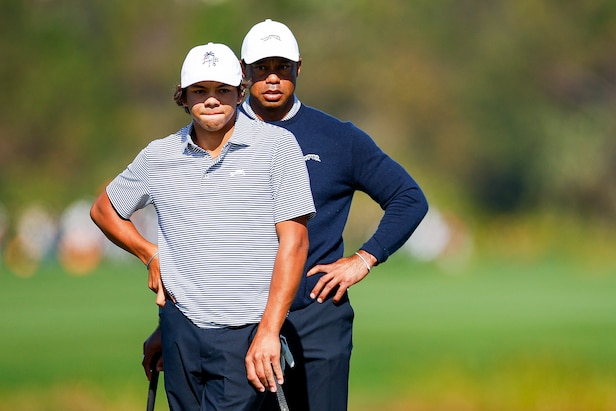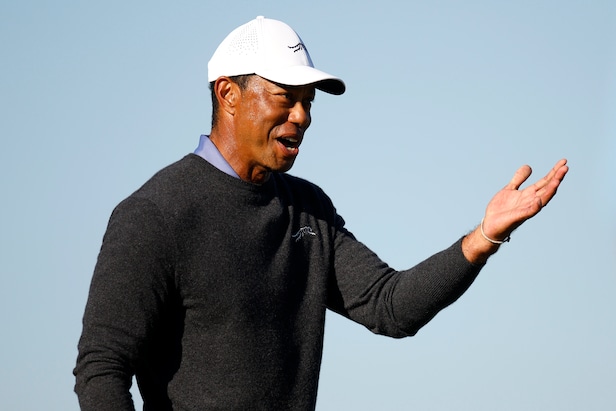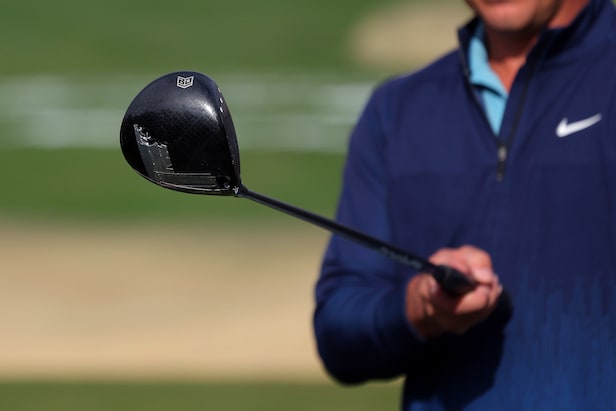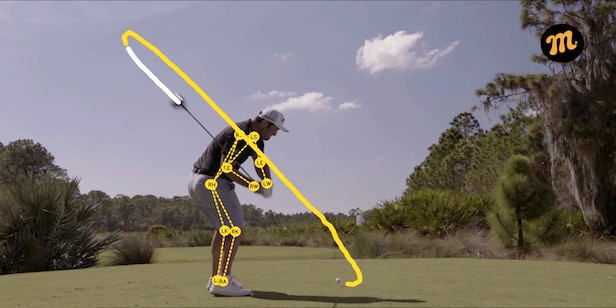Tour Pro’s Little Helper: Does nicotine create a competitive advantage? – Australian Golf Digest

- by Admin
- October 1, 2024
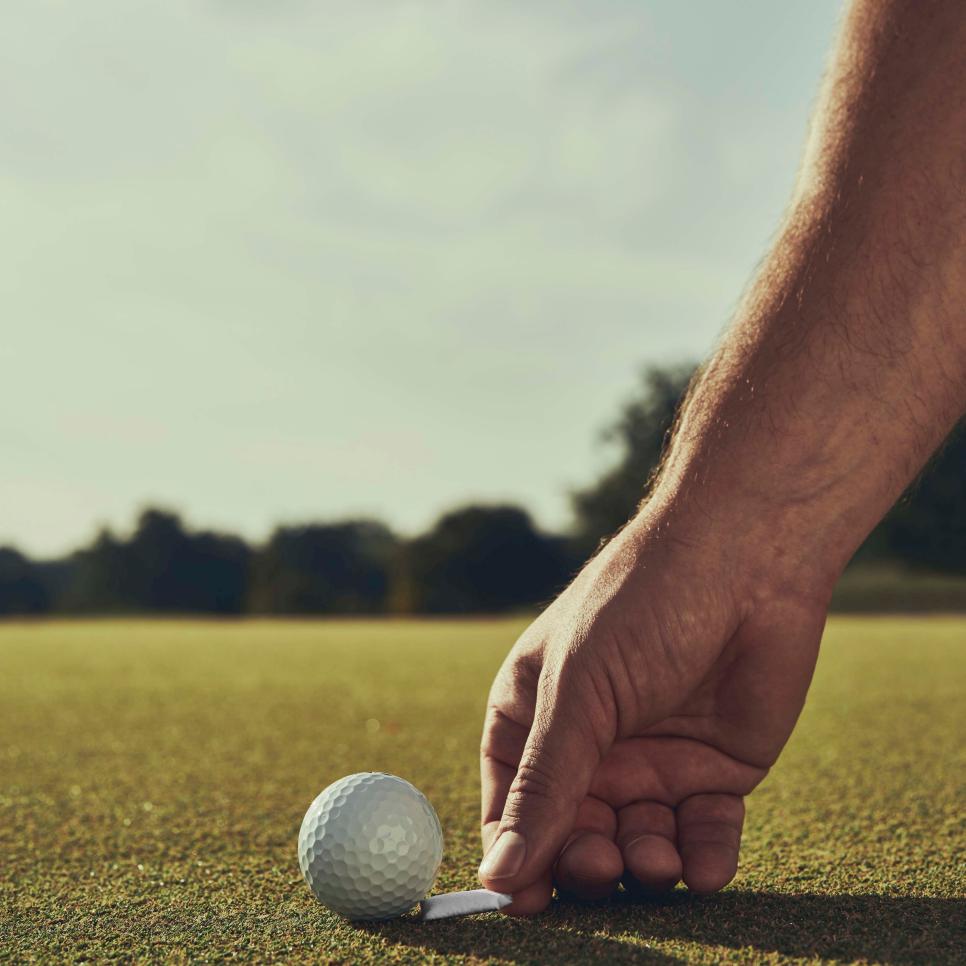
When PGA Tour player Sam Ryder found himself six over par through eight holes in the first round of the Honda Classic, he knew he needed to do something to change his mojo. He had sometimes used oral nicotine pouches to rev up for gym workouts or on the range before super-early tee times. So he popped one in and went to the next tee.
Ryder birdied six of the last 10 holes, following his front-nine 40 with a 31 on the back.
“I needed a little jolt there, and I went on a nice run. I left the pouch in for the rest of the round,” Ryder says. “There are times like that when you don’t feel like you’re clicking, and nicotine can help. I’m not going to do it when I’m three or four under par.”
“I’ll have one [a “dip” of smokeless tobacco] after I make bogey,” says Pat Perez, a three-time PGA Tour winner now playing on LIV Golf. “Some people say you’re supposed to have it after you make birdie because it’s like a reward [laughs]. But I get mad and put one in. If I don’t make a bogey, I might not have one all day.”
In all, we talked to nearly 100 pro golfers to learn more about the popularity and usage patterns of nicotine on the major professional tours. Some told us they turn to tobacco or nicotine products for an energy boost; others say it helps them concentrate or feel relaxed. But for many, it’s just about keeping on.
“When I’m putting in a long practice session, I’ll put in a ZYN (a brand of nicotine pouches) to kind of maintain my focus, stick with my routine and get things done,” says Tim Herron, who plays on the 50-and-older PGA Tour Champions. “I think my mind would maybe wander a little bit if I’m not doing it.”
One PGA Tour rookie told us he breaks out the pouches as soon as he gets to the course. “I won’t play golf without them, even when I’m warming up,” he says. “If I’m snacking, I take it out, but as soon as I’m done, I’ll put one right back in. … For me, they have a calming effect.”
Studies have shown nicotine can increase physical vigor and mental acuity. Since 2012, the World Anti-Doping Agency, an organization funded in part by the Olympic Movement, has been monitoring the drug to determine if it (a) enhances performance (b) presents health risks or (c) goes against the spirit of sport. At present, all athletes can use nicotine freely and legally.
‘It’s Over Half of the Guys’
Golf has a long history with nicotine. In the 1960s and ’70s, tour players walked the fairways with cigarettes dangling from their mouths. Next came smokeless tobacco, fine cut and long cut that players would pack into the lower lip, then tobacco-filled oral pouches.
On tour today, smoking is almost nonexistent, and tobacco-free nicotine pouches have replaced much of the smokeless stuff, often called “dip” or “chew” or “dirt.” Away with the halos of smoke and bulging cheeks went much of the cancer risk.
“Nicotine without tobacco, when used in moderation, is not a major health issue, but I’m concerned about the need for increasing doses,” says Frank Etscorn, Ph.D., professor emeritus at New Mexico Tech and inventor of the nicotine patch in 1986. “The more people use nicotine, the more the body craves it. All too often it becomes a lifelong addiction.”
Today’s nicotine pouches are tiny (about an inch by a half inch), and players can tuck them discreetly under the upper lip. And no tobacco means no need to spit, so the product and the process have become less offensive.
MARK THIS MOMENT With tobacco-free pouches, nicotine use in pro golf is booming.
Daniel Brown
“Smokeless tobacco has traditionally been associated with southern or rural locales, but the nicotine pouches that are popular now seem to have found acceptance among a wider audience,” says Vaughan Rees, Ph.D., the director of the Center for Global Tobacco Control and a faculty member of the Harvard T.H. Chan School of Public Health. “They might be considered a cut above conventional forms of tobacco.”
These little white pouches, from brands like ZYN, Rogue, Zone, LYFT, On! and VELO, have made nicotine use essentially invisible—and almost certainly more popular.
“I’d say it’s over half of the guys out here [on the PGA Tour] who do some sort of tobacco or nicotine pouch,” says Brandt Snedeker, a two-time Ryder Cupper and not a user. “I would guess 60 to 70 percent of caddies use nicotine. It’s rarer out here to find a caddie-player duo where one of them doesn’t do nicotine than a duo where one of them does.”
“It’s not 50 percent,” Ryder says, “but it’s creeping in that direction.”
Billy Horschel, an eight-time PGA Tour winner and also a non-user, doesn’t think it’s quite that high. “If there’s 20 guys hitting balls on the range, I’d say seven or eight are using nicotine. Not much traditional tobacco anymore, mostly pouches, so you don’t see the nasty spitting.”
“It’s rarer out here to find a caddie-player duo where one of them doesn’t do nicotine than a duo where one of them does,” says Brandt Snedeker, a two-time Ryder Cupper and not a user.
On LIV Golf, our interviews indicate that usage among players is more like 25 to 30 percent. One reason for the lower rate might be the lack of availability of nicotine products in some of the foreign countries where LIV Golf plays. One LIV golfer based in the U.S. says he has to “buy out the stores” when he’s home to stock up for extended trips to places like Saudi Arabia, Hong Kong and Morocco.
Toby Mündel, Ph.D., a professor of kinesiology at Brock University in Ontario, helped conduct a nine-year study that analyzed more than 60,000 doping-control tests of competitive athletes worldwide. For many of the sports surveyed, including golf, nicotine was detected at a higher rate than tobacco use in the general population, estimated at 20 percent. Golf was singled out in two of the years as golfers tested positive for nicotine in the 40-percent range.
Despite the lower cancer risk with tobacco-free pouches, any chemical as widely consumed in pro golf as nicotine demands further research, for one, to head off other potential health hazards, but also to find out whether legions of players are gaining an unfair advantage.
RELATED: Sam Bennett packs ZYNs from random fans at the U.S. Open
How Nicotine Works
As a stimulant drug, nicotine impacts the brain and body in various ways. The most obvious effect is an almost immediate rise in heart rate and blood pressure, which creates physical arousal, more energy and heightened sensitivity in the body.
On the psychological side, nicotine can improve concentration, mental clarity, reaction time and memory. These changes could help with critical analysis and decision-making and even create an overall sense of well-being.
The dangers of traditional forms of nicotine consumption are staggering. According to the Centers for Disease Control and Prevention, smoking causes more than 480,000 deaths annually in the U.S., and smokeless tobacco is a known cause of cancer. While less is understood about the risks of nicotine alone, experts say it is a powerful substance and far from harmless.
Neal Benowitz, M.D., former head of clinical pharmacology at University of California San Francisco, has been studying the drug’s effects for more than 40 years. “Nicotine augments the release of chemicals in the brain called neurotransmitters,” he says, “chemicals like dopamine, which causes feelings of pleasure; adrenaline, for physical stimulation; and serotonin and endorphins, which bring on relaxation.”
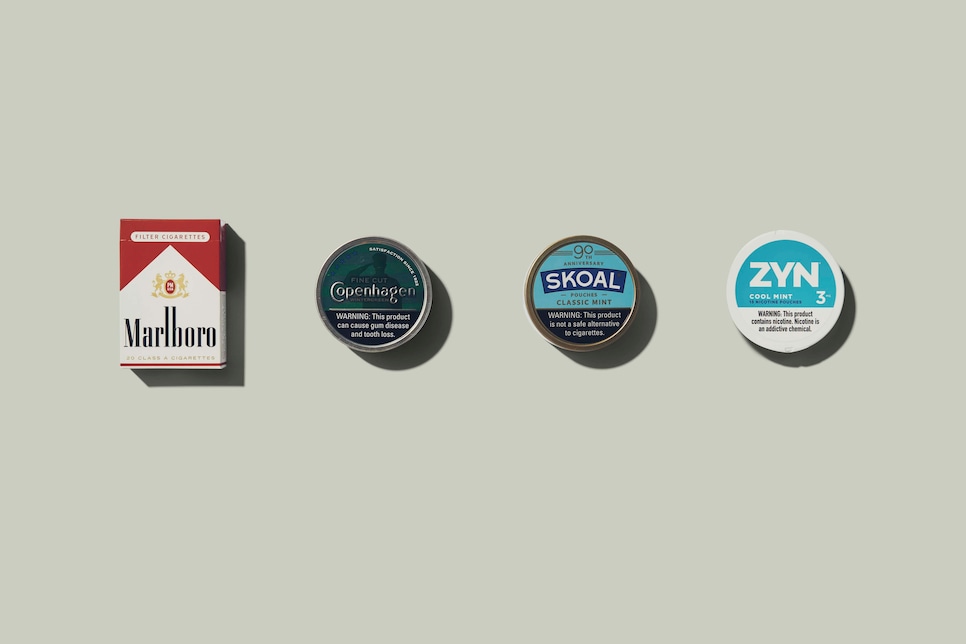
WHAT’S IN MY BAG Usage has evolved from cigarettes to smokeless tobacco to pouches.
Daniel Brown
With pouches, peak nicotine concentration in the body occurs in about 30 minutes. A second dose at 60 to 90 minutes after initiation prevents the nicotine level from dropping to the point of little effect.
“People learn to modulate the ups and downs,” Benowitz says. “Smokers manage their mood by choosing when to have a cigarette. When they’re stressed, they smoke to feel less stress; when they feel lethargic, they get an energy boost. All nicotine works like that.”
Transdermal and oral forms deliver the chemical into the bloodstream very quickly, so the effects are instantaneous. “If someone wants a quick nicotine bump, a pouch is an effective way to get it,” Etscorn says.
Rees makes the connection to sports. “Nicotine can help you focus your mind on a task and tune out extraneous noise, so you settle into a better state of performance. It can help with what athletes call ‘getting in the zone.’”
The Sneaky Benefits
“I don’t know if it helped me focus,” says Marco Dawson, a PGA Tour Champions player who switched from “dipping” to a no-tobacco pouch that doesn’t even contain nicotine. “A dip made me feel calm. It was something to do, a way to change the circumstances around me.”
With its power to stimulate, nicotine would seem to be useful only for accelerating the user’s mind and body, but that’s not always the case. Some tour players we interviewed mentioned feeling a sense of comfort or relaxation. This apparent contradiction can be explained by looking at consumption patterns.
“You have strategic users and dependent users,” says Ara Suppiah, M.D., an ER physician and performance coach who advises athletes including Brooks Koepka, Xander Schauffele and Phil Mickelson. “The strategic user turns to nicotine for a pick-me-up, and the dependent user relies on it to just feel normal.
“The strategic guy is feeling more of the stimulant effect of the drug, and the dependent guy is getting comfort from the familiarity and the routine.”
This is what’s called a conditioned response, where a certain response is linked to a certain behavior. Pavlov’s dogs learned to associate feeding with the sound of a bell and eventually would salivate just on hearing the bell. If someone is comforted by the routine of tobacco or nicotine, the process of putting in a pouch, even the sight or smell of one, might be enough to relax him or her. In effect, the anticipation of feeling good outweighs the physical stimulation.
“It’s a lot like caffeine. People have coffee in the morning for a jolt, then drink it in the evening to wind down. Nicotine also can do both,” Etscorn says. “Users can control the arousal effect of the drug.”
Suppiah relates it to golf: “Some of my players who use nicotine regularly put in a pouch when they get agitated because they’re dragging or feeling slow. It’ll give them a physical boost, but more importantly, they feel the agitation going away. They’ve developed a conditioned response: pouch equals feeling good.”
It’s Not One Size Fits All
Tom House is a renowned pitching coach who has worked with hundreds of MLB players from Nolan Ryan to Randy Johnson and NFL quarterbacks including Tom Brady and Drew Brees. For five decades, House has seen baseball players use tobacco in calculated ways.
“Elite athletes are geniuses at self-modulating, using tools they have to enhance or support whatever they’re being asked to do, whether that’s going to the plate or sitting in the bullpen,” House says. “Tobacco is a tool, and they wouldn’t do it if it wasn’t worth it.
“Relief pitchers spend the whole game fighting boredom, and then the call comes. Many of them have figured out how to satisfy a need state—stimulation or relaxation—in part by chewing tobacco. When they get the call to come in, some spit it out, some put more in. They know what works for them in that moment.”
Suppiah agrees that any potential benefits from nicotine are highly individual—and learned. “If a player is a type-A who competes better when fired up, nicotine can help him maintain arousal,” he says. “Some players are better when they’re very calm, so the stimulation would work against them. It’s personality-based.”
“You see nicotine more in sports that are longer in duration, like golf and baseball,” says one prominent swing coach who works with several tour players. “Golf is four or five hours, then you add in warm-ups and practice after a round. It’s a long day. It helps some guys manage things, but it doesn’t help everybody who does it.”
Herron takes an even broader view. “We’re looking for a routine when we’re on the road because everything is so inconsistent—flights, hotels, car rental,” he says. “We’re always looking for something that keeps us even-keeled, and this kind of chills it out.”
Dosing—both the timing of doses and the strength—is also a big part of the equation. Again, caffeine provides a good comparison. “One espresso makes you feel energetic, but two or three might make you feel terrible. Nicotine is just like that,” Suppiah says. “The right amount for a person who tolerates it well will be a plus, but there’s a tipping point.”
As Ryder told us, “If I put in [a pouch] on the wrong day, like when I’m feeling anxious or didn’t get a good night’s sleep, I’ll get jittery, or my mind will start racing. I just ditch it because I know it’s going to make things worse.”
‘Zero Effect on My Golf’
Most players we talked to, including those who use tobacco or nicotine pouches, said they don’t think there are performance advantages. They often referred to nicotine as simply a “routine” or “something to do.”
“What I know is that the best players in the world, they’re not using it,” Horschel says. “I don’t see guys putting in a pouch and anything changing over the next several holes.”
One major-championship winner said players are using nicotine primarily to cope with boredom. “It just helps pass the time. I don’t think there’s anything game-enhancing about it. It’s just a habit you pick up working outside, nothing more.”
Perez was more adamant: “I don’t see one benefit on the course. Zero. It’s just what some people do. … If I had to quit today, it would have zero effect on my golf.”
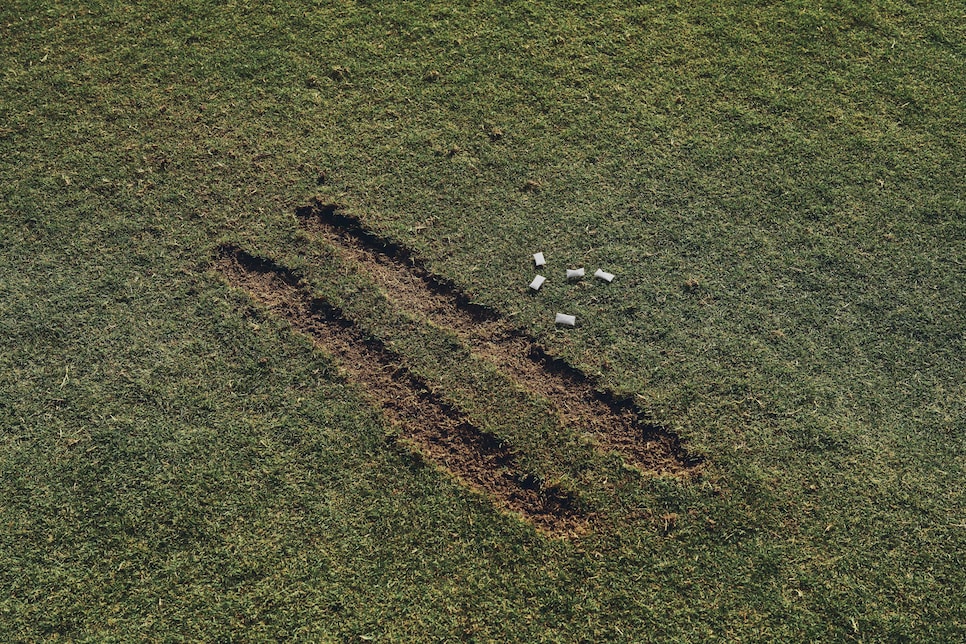
TOUR PROS WERE HERE All in a day’s work at the practice range.
Daniel Brown
Some players might be getting benefits without knowing it. Without nicotine, regular users often feel withdrawal symptoms—irritability, anxiety, fatigue—and one dose reverses those symptoms. It’s less of a boost, more of a leveling device.
Dawson, the no-nicotine pouch user, says, “I don’t know if there are performance benefits to any of it, but if you think there are, that’s probably going to help you.”
“It’s like a placebo effect,” says another LIV Golf player and smokeless-tobacco user. “I think some players think it makes them feel better, and they start getting positive vibes, and they hit better shots. I wish that were me [laughs]. For me, it’s just a nasty habit.”
MORE: Why serious players are dosing psychedelics like mushrooms and ayahuasca
Health Risks and Negative Impacts
The value of nicotine as a performance tool may be debatable, but some health risks from habitual use are not.
“People build up a tolerance to nicotine, so the more they use it, the higher the dose they need,” Etscorn says. “It’s not even to get a benefit as much as it is to reach normality.”
After a while, they’re not really getting pleasure from the nicotine, they’re just getting rid of withdrawal symptoms.
“They might turn to more harmful behaviors, like smoking or vaping. Nicotine can act like a gateway drug, and the question is, what will they do to get more nicotine? That’s the real health risk.”
Other issues can result from the rapid arousal of the heart and circulatory system.
“You have strategic users and dependent users,” says Dr. Ara Suppiah, a tour performance coach. “The strategic user turns to nicotine for a pick-me-up, and the dependent user relies on it to just feel normal.”
“Nicotine, as a stimulant, primarily affects the user’s cardiovascular system, but exactly how it impacts athletes during play needs to be studied further,” says Mündel, who worked on the nine-year nicotine study. “We know nicotine use could certainly increase the health risk for people who have underlying cardiovascular issues.”
“There are concerns that it might cause oral pathology. We know nicotine is inadvisable for pregnant women and people with a history of heart disease,” UCSF’s Benowitz says. “If someone were to have a heart attack while using nicotine, the odds of it being a fatal event would increase.”
The negative impact of individual doses could range from minor physical annoyances to performance-destroying consequences. “Changes in heart rate or blood pressure are common side effects that may impact sports performance,” says Tory Spindle, Ph.D., a researcher in behavioral pharmacology at Johns Hopkins, “but there are other effects that may be relevant and likely lead to worse performance, such as nausea, upset stomach, sweating and lightheadedness.”
One PGA Tour player told us nicotine mostly has a negative impact on him. “I do it when I need to reset or change my mood, but I think it gives me anxiety. I get heart palpitations. It’s part of my routine now, but I wish I didn’t do it.”
The LIV golfer who called his dipping a nasty habit also said it takes away his appetite. “I saw a nutritionist, and they couldn’t believe I was going so long without eating on the golf course. The dip keeps you from eating, so that’s a downside for sure.”
Also highly concerning is the explosion in popularity of nicotine pouches among teenagers, who are still developing mentally and physically. Peer pressure can cause them to try these products and then face dependency. Related behaviors, namely smoking and vaping, are exponentially more dangerous and more likely the earlier in life someone starts using nicotine.
Mündel says all of this must be weighed at the societal level: “These pouches might be the least harmful way of getting nicotine, especially compared to tobacco, but because they’re legal and so readily available, the high number of potential users is the big concern.”
Where Do We Go From Here?
“Great players are always finding ways to manage their minds and bodies for better performance. Nicotine is one option they have, like caffeine or CBD,” says Suppiah, who has served as a Ryder Cup team physician six times. “Once they learn how it affects them and can tolerate any adverse effects, it can 100 percent give them an advantage.”
Can nicotine make a golfer better than they would be without it? The issue of dependency clouds the picture.
“When someone becomes dependent, it gets difficult to disentangle whether the nicotine is giving them any enhancement or cognitive benefits over and above their normal abilities prior to nicotine initiation, or if they simply feel an enhancement because they were in a state of withdrawal from not using nicotine recently,” Spindle says.
We’re left to consider three types of players: the non-user, the non-dependent user and the dependent user. Non-users have no risk of dependency but might be passing up performance benefits. Non-dependent users likely experience favorable effects from nicotine, but they walk a tricky line between occasional use and addiction. Dependent users need nicotine to feel normal and battle withdrawal symptoms.
Bryson DeChambeau, the reigning U.S. Open champion and a non-user, sums up the situation well: “I think there are potentially benefits for a lot of people, and it’s not illegal. Does it help players? It may or may not. We’re all looking for an edge out here, and if that gives them an edge, hats off to them. It’s not illegal. What I can tell you is, definitely more research needs to be studied on it.”
One evening while reporting this story, we approached a multiple-major winner on the driving range of a PGA Tour Champions event. He had never heard of the potential benefits of using nicotine, nor did he know much of anything about nicotine pouches. After a few minutes of conversation, he asked if we had any on us. He wanted to try it the next morning in the tournament and then let us know how it went.
More From Golf Digest+ 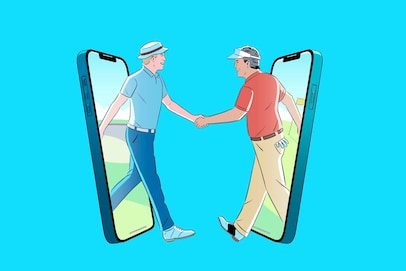 An inside look at the new way to get onto any private course
An inside look at the new way to get onto any private course  Golf Digest’s Best Young Teachers in America (2025-2026)
Golf Digest’s Best Young Teachers in America (2025-2026)  Golf Digest Logo How Callaway’s oversized driver revolutionized golf
Golf Digest Logo How Callaway’s oversized driver revolutionized golf
This article was originally published on golfdigest.com
The Latest News
-
December 22, 2024India boycott press match after media battles
-
December 22, 2024Australian Open runner-up Zheng out of United Cup
-
December 22, 2024Nick Kyrgios results: Australian defeated in long-awaited comeback | Sporting News Australia
-
December 22, 2024China’s Olympic medallist Zheng to skip United Cup to stay fresh for Australian Open
-
December 22, 2024Zheng Qinwen to Kick Off 2025 Season at Australian Open | Sports-Games
